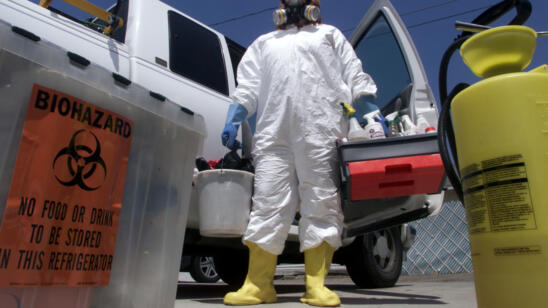For a brief period on the evening of July 12, 2014, Conrad Roy decided he wasn’t yet ready to die.
The 18-year-old exited his pickup truck, which was filling with carbon monoxide fumes, and breathed in the fresh air of Fairhaven, a small coastal town in Massachusetts.
But Roy returned to the toxic truck after his friend Michelle Carter, 17, who was born in Plainville, Massachusetts, ordered him back inside, she confessed to a friend.
The toxic gas killed Roy, and in 2017, Carter was convicted of involuntary manslaughter.
The case against Carter was the subject of an episode of American Justice, that aired September 17, 2021 on A&E. [You can watch the episode here on the A&E site and apps.]
The verdict roiled the legal world in a debate over First Amendment rights as hundreds of emotional texts between the two teenagers went viral.
Carter was released from prison on January 23, 2020, but the free speech debate continues, including proposed legislation to curb coercing suicides.
The case broke new ground on digital communications and “how we develop a real extension of ourselves through the use of the personal computers we hold every day,” past Boston Bar Association President and attorney Carol A. Starkey tells A&E True Crime. “And that has its own implications.”
‘You just have to do it’
Carter and Roy met in 2012 while vacationing in Florida and struck up a friendship that spiraled into a fatal bond, although the two lived about 50 miles apart in Massachusetts and communicated mainly by phone and texts.
Both experienced mental health problems, according to court documents, and Roy struggled with depression. He had tried to commit suicide several times in different ways, including overdosing on acetaminophen, suffocating and drowning.
Initially, Carter tried to dissuade Roy from taking his own life and implored him to seek help at a mental health hospital where she was treated for an eating disorder.
When Roy spoke of suicide in October 2012, Carter told him not to. “You have so much to live for,” she texted.
But the despair Roy felt persisted, and Carter’s tone shifted. The two conferred frequently about suicide logistics in summer 2014 and what type of portable machine could effectively produce carbon monoxide.
When Roy expressed doubts about going through with killing himself: “I have a bad feeling [that] this is going to create a lot of depression between my parents/sisters,” Carter had a counter-argument.
“There’s a point that comes where there isn’t anything anyone can do to save you, not even yourself, and you’ve hit that point,” she texted.
Carter also exhorted Roy, saying “YOU KEEP PUSHING IT OFF! You just said you were gonna do it tonight and now you’re saying eventually.”
Around dinnertime July 12, 2014, Roy drove his pickup truck to a deserted parking lot and turned on a gas-powered water pump, causing carbon monoxide to seep into the cab.
He and Carter exchanged two long phone calls that night.
According to a text Carter sent to a friend in September 2014, “I was on the phone with him and he got out of the car because [the carbon monoxide] was working and he got scared and I [expletive] told him to get back in … because I knew he would do it all over again the next day and I couldn’t have him live the way he was living anymore.”
Manslaughter or cyber-bullying?
After a trial in Bristol County Juvenile Court, Judge Lawrence Moniz issued his ruling on June 16, 2017.
Carter’s attorney Joseph Cataldo had argued Roy was determined to take his own life and his death was a suicide, not a homicide.
But Moniz found Carter guilty of involuntary manslaughter and focused on her command to “get back in the truck.”
Carter’s “virtual presence,” overwhelmed Roy’s willpower, and “but for the defendant’s admonishments, pressure and instructions, the victim would not have gotten back into the truck and poisoned himself to death,” Moniz ruled.
The American Civil Liberties Union (ACLU) of Massachusetts protested, saying the decision violated free speech protections and could have a chilling effect on end-of-life discussions.
Northeastern University criminal law professor Daniel S. Medwed tells A&E True Crime that the verdict was flawed, but not for First Amendment reasons.
Medwed, a founding member of the board of the Innocence Network that works to overturn wrongful convictions, recalls his first reaction was that prosecutors were “over-reaching.” “This is not manslaughter, it’s basically cyber-bullying,” says Medwed, a former defense attorney.
“The causation piece was a problem because [Roy] had attempted suicide and backed out before. So for [Carter] to know it was foreseeable and that he would follow through was a little bit of a stretch,” says Medwed.
Arguing that the manslaughter charge wasn’t a specific enough charge in Carter’s case, Medwed and colleagues spearheaded a law codifying coerced suicide as a crime with support from Roy’s mother, Lynn.
Conrad’s Law makes coerced suicide—by someone who knows a person’s suicidal tendencies and encourages them to take their own life—a felony punishable by up to five years in prison.
The law was introduced into the Massachusetts legislature in 2019 and is still pending as of September 2021.
Worst case scenarios
Concerns about the role of digital communication, such as Carter’s texts, when it comes to crime are amplified with COVID-19, experts say.
Former federal prosecutor and law professor Laurie Levenson tells A&E True Crime the pandemic-related surge in virtual interaction “really opens the door to more criminal responsibility than we’ve seen in the past. What’s really troubling, is when you get into words, not only do you have the issue of what the intent is in saying the words, but what do you anticipate the impact is going to be?”
And, “I really worry about the things immature people say to each other, because they’re not thinking down the road towards the consequences of their words,” says Levenson, a professor at Loyola Marymount University Law School.
For trial lawyer Starkey, the worst type of fallout would be “we have someone who is a schoolyard bully or makes a stupid, in poor taste joke that causes an unstable person to commit suicide and – suddenly—they’re up on manslaughter charges.”
In Roy’s death, Starkey believes the dots were uniquely connected because of repeated attempts to take his life, the teens’ relationship and lengthy texts where Carter aids with suicide plans and resists delays.
“The concern is there is going to be a case where we do not have all these pieces of evidence that connect the dots of causation from verbal speech or conduct to the final suicide. And, that’s where you worry that freedom of speech is going to be eroded.”
‘I think he was in pain’
Another deciding factor in Moniz’s verdict was Carter’s failure to act as Roy was dying. “She did not call the police or Mr. Roy’s family” to intervene, he said.
But Levenson notes that legally “we don’t have a broad responsibility to save people in the U.S. There’s no Good Samaritan law.”
For psychologist, Michael G. Wetter, an author and expert on adolescent psychology, the case red-flags expanding concerns about digital technology and communication—ranging from youths eating detergent pods in reaction to social media posts to encouraging suicide.
Carter “didn’t have to look at [Roy’s] face while he suffocated. I think it could have made a huge difference. It’s one thing to conceptualize something, it’s another thing to view it,” Wetter tells A&E True Crime.
Regarding Roy, “I think he was scared. I think he was in pain,” says Wetter.
“In a moment where he was very ambivalent, her communication to him reflected no ambivalence. Her comments were not, ‘I don’t know what you should do. Maybe you should go home. Maybe there’s other things we can do.’ There wasn’t that. There was—’get back in the car.'”
He adds, “suicide is a very permanent action for a state of mind that is temporary even if the pain that you’re feeling has been going on for weeks and months—that’s still temporary relative to eternity. There are always other options.”
Help is available at the National Suicide Prevention Lifeline. Call 1-800-273-8255.
Related Features:
Watch Episodes of ‘Cold Case Files’
Was Jonestown a Mass Suicide or a Mass Murder?
Murder, Suicide or Accident? The Chilling Mystery of Elisa Lam’s Death


